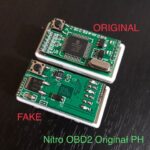Dealing with engine trouble codes can be frustrating, especially when your car’s idle starts acting up after routine maintenance. One such code you might encounter is P0505, indicating an issue within your vehicle’s idle control system. This article delves into the P0505 code, drawing insights from real-world experiences to help you understand and potentially address this problem.
The P0505 code generally points to an Idle Air Control (IAC) system malfunction. This system is crucial for maintaining a stable engine idle speed under various conditions. When the Engine Control Unit (ECU) detects that the idle speed is not within the expected range, and it cannot properly control it through the IAC system, it may trigger the P0505 code and illuminate the Check Engine Light.
Symptoms of a P0505 Code
While a P0505 code is a diagnostic indicator, you’ll likely notice some performance issues accompanying it. Common symptoms include:
- High Idle Speed: The engine idles at a higher RPM than normal, even after warming up.
- Unstable or Fluctuating Idle: The RPMs may surge up and down erratically when the vehicle is idling.
- Stalling: The engine may stall, particularly when coming to a stop or at low speeds.
- Near Stalling: The engine RPMs might drop very low, almost stalling, before suddenly surging back up.
- Difficulty with Relearn Procedures: After cleaning components like the Mass Air Flow (MAF) sensor or Throttle Body (TB), the ECU may struggle to relearn the idle settings.
Potential Causes of P0505
Several factors can contribute to a P0505 code. Understanding these potential causes is the first step in effective troubleshooting:
- Faulty Idle Air Control Valve (IACV): The IACV itself could be malfunctioning due to mechanical failure, electrical issues with the solenoid, or carbon buildup preventing proper operation.
- Vacuum Leaks: Leaks in vacuum lines can disrupt the air-fuel mixture and affect idle control.
- Throttle Body Issues: A dirty or improperly functioning throttle body can interfere with idle air regulation.
- MAF Sensor Problems: Although often cleaned for maintenance, a faulty MAF sensor can send incorrect air flow readings to the ECU, impacting idle control.
- ECU Issues: In rare cases, the ECU itself might be faulty, misinterpreting signals or failing to control the IAC system correctly.
- Wiring or Connector Problems: Damaged wiring or loose connectors in the IAC system circuit can disrupt communication and function.
Real-World Example: Troubleshooting P0505
Consider the experience of one car owner who faced idle issues after cleaning their MAF sensor and throttle body on a 1998 vehicle. Initially, they encountered high and fluctuating RPMs, and the engine wouldn’t complete the idle relearn procedure. This mirrors symptoms often associated with a P0505 code, even though a code wasn’t initially present.
After cleaning the Idle Air Control Valve (AICV) – a common term for IACV in some vehicles – the problems persisted. Interestingly, after these DIY attempts, OBD codes P0325 (Knock Sensor Circuit Malfunction) and P0100 (Mass Air Flow Circuit Malfunction) appeared, likely due to accidental disconnection or the MAF cleaning process itself. Resetting the ECU cleared these codes, but the original idle issue remained.
Seeking professional help, the owner took their vehicle to a Nissan dealership. After a diagnostic assessment, the dealership concluded that the AICV solenoid was faulty and recommended replacement. While replacing the AICV improved the high idle issue, it didn’t completely resolve the problem. The vehicle still experienced near-stalling and surging RPMs, indicating the issue was more complex than initially diagnosed. This highlights a crucial point: diagnosing P0505 can sometimes be challenging, and a single component replacement may not always be the complete solution.
Troubleshooting Steps for P0505
If you encounter a P0505 code, a systematic approach to troubleshooting is essential:
- Visual Inspection: Check for vacuum leaks by inspecting hoses for cracks or disconnections. Examine wiring and connectors to the IAC valve and MAF sensor for damage or looseness.
- Clean the IACV/Throttle Body: Carefully clean the IAC valve and throttle body, removing any carbon buildup that could be hindering their operation. Use appropriate cleaners designed for these components.
- Test the IACV: Use a multimeter to check the resistance of the IACV solenoid. Refer to your vehicle’s repair manual for the correct resistance values. You can also try applying power to the solenoid to see if the valve moves freely.
- MAF Sensor Check: Inspect the MAF sensor for damage and ensure it’s properly connected. While cleaning is common, be cautious as MAF sensors can be delicate.
- Scan for Other Codes: Check for any other accompanying OBD codes that might provide additional clues to the underlying problem.
- Professional Diagnosis: If DIY efforts don’t resolve the issue, seeking professional diagnosis is advisable. A qualified mechanic can use specialized tools and knowledge to pinpoint the exact cause of the P0505 code.
Conclusion
The Obd2 Code P0505 indicates a malfunction in the idle control system, often related to the Idle Air Control Valve. Symptoms like high idle, fluctuating RPMs, and stalling are common indicators. While cleaning components like the MAF sensor and throttle body is a part of routine maintenance, it can sometimes inadvertently trigger or highlight underlying issues within the idle control system. As illustrated by real-world experiences, diagnosing and resolving P0505 can require careful troubleshooting and may involve more than just replacing a single part. A systematic approach, starting with basic checks and progressing to professional diagnostics when needed, is the best way to effectively address a P0505 code and restore your vehicle’s smooth idle operation.
